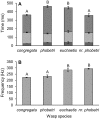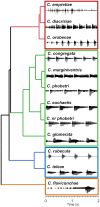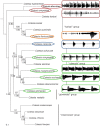Evolutionary relationships of courtship songs in the parasitic wasp genus, Cotesia (Hymenoptera: Braconidae)
- PMID: 30608965
- PMCID: PMC6319714
- DOI: 10.1371/journal.pone.0210249
Evolutionary relationships of courtship songs in the parasitic wasp genus, Cotesia (Hymenoptera: Braconidae)
Abstract
Acoustic signals play an important role in premating isolation based on sexual selection within many taxa. Many male parasitic wasps produce characteristic courtship songs used by females in mate selection. In Cotesia (Hymenoptera: Braconidae: Microgastrinae), courtship songs are generated by wing fanning with repetitive pulses in stereotypical patterns. Our objectives were to sample the diversity of courtship songs within Cotesia and to identify e underlying patterns of differentiation. We compared songs among 12 of ca. 80 Cotesia species in North America, including ten species that have not been recorded previously. For Cotesia congregata, we compared songs of wasps originating from six different host-foodplant sources, two of which are considered incipient species. Songs of emergent males from wild caterpillar hosts in five different families were recorded, and pattern, frequency, and duration of song elements analyzed. Principal component analysis converted the seven elements characterized into four uncorrelated components used in a hierarchical cluster analysis and grouped species by similarity of song structure. Species songs varied significantly in duration of repeating pulse and buzz elements and/or in fundamental frequency. Cluster analysis resolved similar species groups in agreement with the most recent molecular phylogeny for Cotesia spp., indicating the potential for using courtship songs as a predictor of genetic relatedness. Courtship song analysis may aid in identifying closely related cryptic species that overlap spatially, and provide insight into the evolution of this highly diverse and agriculturally important taxon.
Conflict of interest statement
The authors have declared that no competing interests exist.
Figures










Similar articles
-
Characterization and generation of male courtship song in Cotesia congregata (Hymenoptera: Braconidae).PLoS One. 2013 Apr 22;8(4):e62051. doi: 10.1371/journal.pone.0062051. Print 2013. PLoS One. 2013. PMID: 23630622 Free PMC article.
-
Motor control of Drosophila courtship song.Cell Rep. 2013 Nov 14;5(3):678-86. doi: 10.1016/j.celrep.2013.09.039. Epub 2013 Oct 31. Cell Rep. 2013. PMID: 24183665 Free PMC article.
-
Singing on the wings! Male wing fanning performances affect female willingness to copulate in the aphid parasitoid Lysiphlebus testaceipes (Hymenoptera: Braconidae: Aphidiinae).Insect Sci. 2016 Aug;23(4):603-11. doi: 10.1111/1744-7917.12201. Epub 2015 Apr 9. Insect Sci. 2016. PMID: 25641835
-
Acoustic Pattern Recognition and Courtship Songs: Insights from Insects.Annu Rev Neurosci. 2019 Jul 8;42:129-147. doi: 10.1146/annurev-neuro-080317-061839. Epub 2019 Feb 20. Annu Rev Neurosci. 2019. PMID: 30786225 Free PMC article. Review.
-
Courtship song analysis of Drosophila muscle mutants.Methods. 2012 Jan;56(1):87-94. doi: 10.1016/j.ymeth.2011.09.007. Epub 2011 Sep 16. Methods. 2012. PMID: 21945578 Review.
Cited by
-
Body size and sequence of host colonisation predict the presence of acoustic signalling in beetles.Sci Rep. 2024 Jul 5;14(1):15532. doi: 10.1038/s41598-024-66108-8. Sci Rep. 2024. PMID: 38969671 Free PMC article.
References
-
- Sueur J. Insect species and thier songs In: Drosopoulos S, Claridge M, editors. Insect Sounds and Communication: Physiology, Behaviour, Ecology and Evolution. Boca Raton, FL: Taylor & Francis; 2006. pp. 207–217.
-
- Ritchie MG, Gleason JM. Rapid evolution of courtship song pattern in Drosophila willistoni sibling species. J Evol Biol. 1995;8: 463–479. 10.1046/j.1420-9101.1995.8040463.x - DOI
-
- Oliveira CC, Manfrin MH, Sene FDM, Etges WJ. Evolution of male courtship songs in the Drosophila buzzatii species cluster In: Michalak P, editor. Speciation: Natural Processes, Genetics and Biodiversity. New York: Nova Science Publishers; 2013. pp. 137–164.
Publication types
MeSH terms
LinkOut - more resources
Full Text Sources
Miscellaneous

